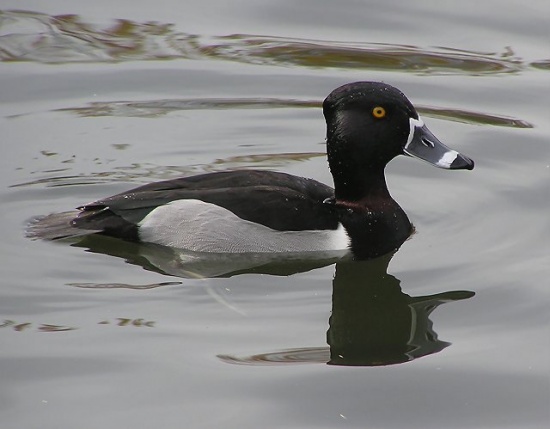- Aythya collaris
Identification
37–46 cm (14½-18 in)
Male
- Grey bill with white band
- Black head which when breeding looks shiny purple
- Highest point of head far behind eye
- White belly
- Yellow eyes
- Back looks black in the field
- White "spur" between breast and sides
- Field guides mention a cinnamon-colored ring around the neck that probably can only be seen in the hand
Female
- Brown head and body, sides of body paler than rest
- White belly visible in flight
- Dark bill with more subtle markings compared to male
- Brown eyes
- White eye-ring may extend behind eye as a stripe
Flight

Photo © by Stanley Jones
Anahuac National Wildlife Refuge, Chambers County, Texas, USA, February 2019
When in flight, both male and female shows a grey stripe on flight feathers.
Similar Species
The very similar Tufted Duck shows white in the wing. The Lesser Scaup is darker overall, and has no eye ring.
Distribution
Breeds in Canada and north west United States; mostly vacates breeding area in winter, migrating to southern USA and Central America, being rare but regular in Panama and a vagrant in South America. Occurs as a vagrant with some regularity in Europe[2][3][4][5].
Taxonomy
This is a monotypic species[1].
Habitat
Breeding on freshwater marches, wooded lakes, rivers and ponds, also found in coastal habitats in winter.
Behaviour
Diet
Their diet consists mostly of aquatic vegetable matter, such as seeds, roots, leaves and tubers, also grass and sedge stems.
Breeding
The bowl-shaped nest is built near water. It is constructed from aquatic vegetation and lined with down. The clutch contains 8 to 10 eggs. They may have replacement clutches.
References
- Clements, J. F., T. S. Schulenberg, M. J. Iliff, D. Roberson, T. A. Fredericks, B. L. Sullivan, and C. L. Wood. 2018. The eBird/Clements checklist of birds of the world: v2018. Downloaded from http://www.birds.cornell.edu/clementschecklist/download/
- Restall et al. 2006. Birds of Northern South America. Yale University Press. ISBN 9780300124156
- Ridgely & Gwynne 1989. Birds of Panama. Princeton Paperbacks. ISBN 0691025126
- Beaman, M., S. Madge, K.M. Olsen. 1998. Fuglene i Europa, Nordafrika og Mellemøsten. Copenhagen, Denmark: Gads Forlag, ISBN 87-12-02276-4
- National Geographic Society. 1987. Field Guide to the Birds of North America. Washington DC: National Geographic Society.
- Handbook of the Birds of the World Alive (retrieved February 2019)
Recommended Citation
- BirdForum Opus contributors. (2025) Ring-necked Duck. In: BirdForum, the forum for wild birds and birding. Retrieved 11 May 2025 from https://www.birdforum.net/opus/Ring-necked_Duck
External Links
GSearch checked for 2020 platform.1





